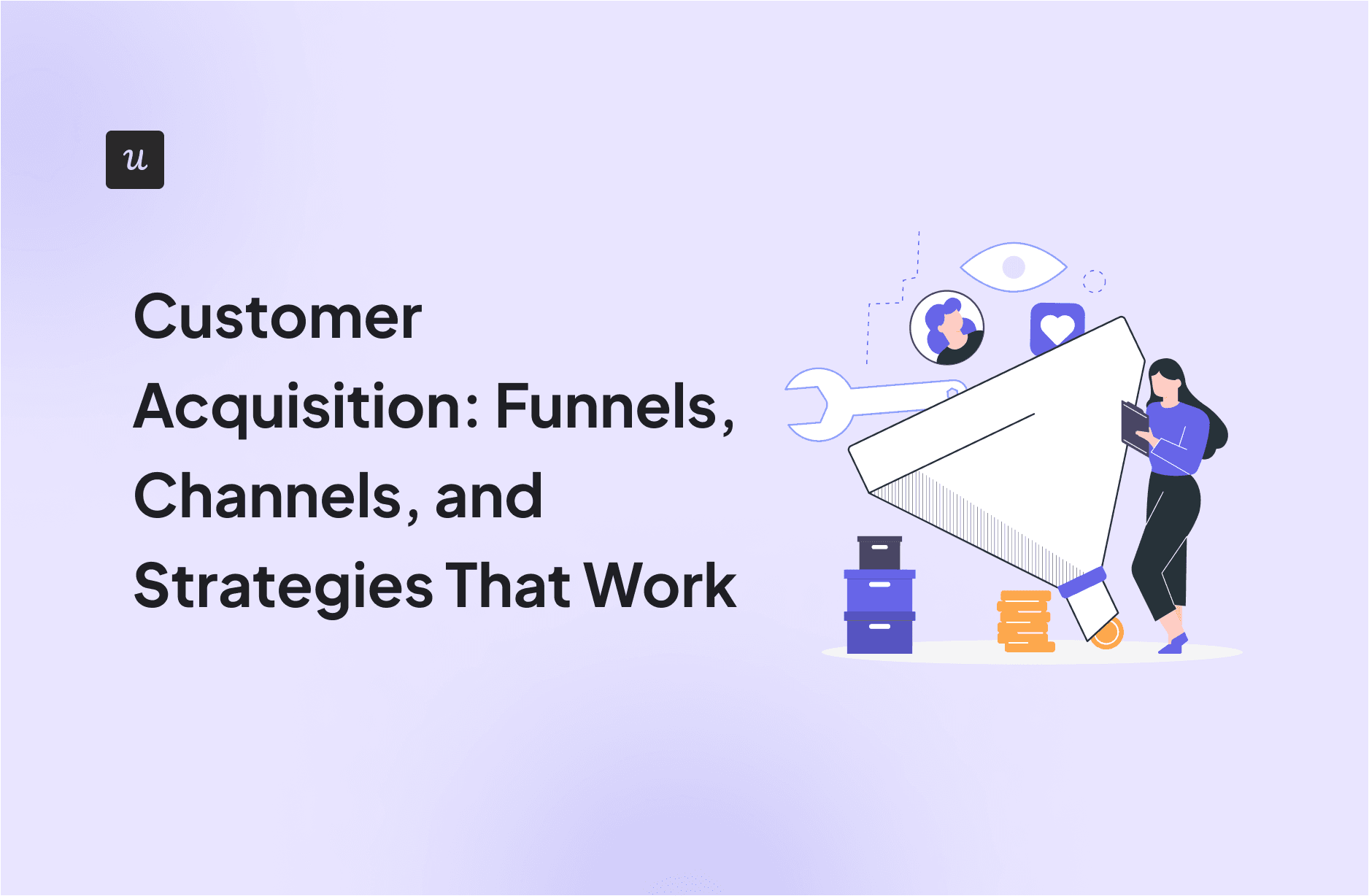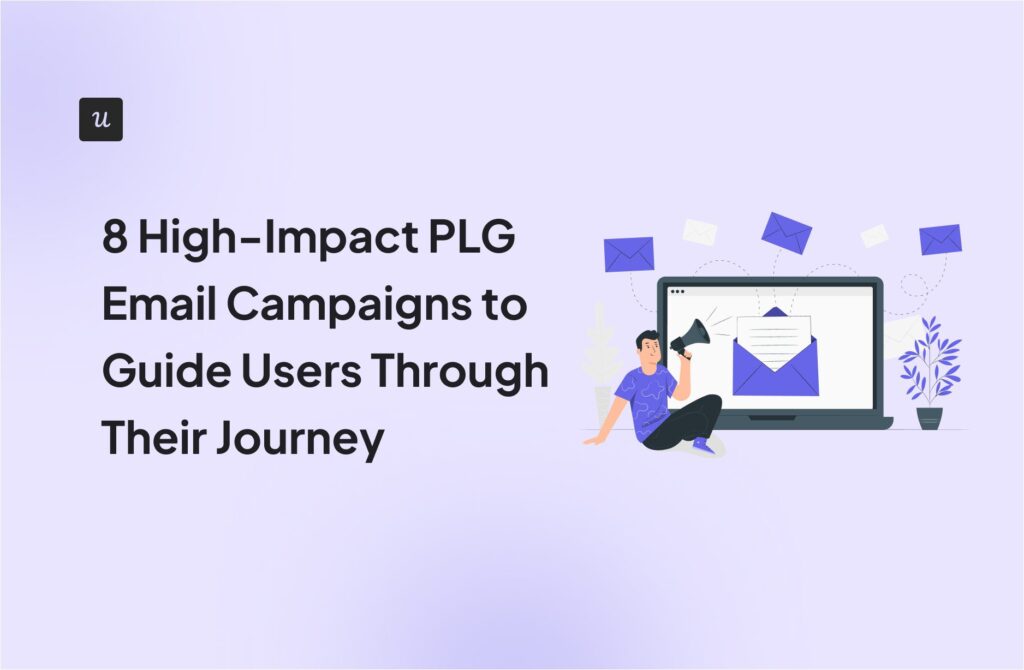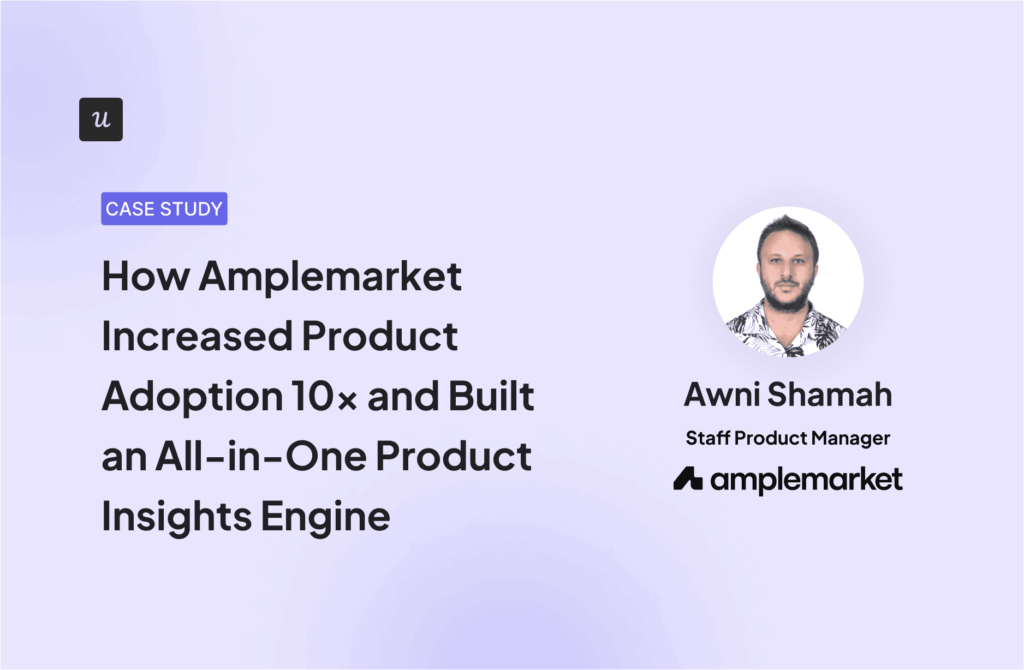
Are you struggling to understand why your customer acquisition efforts aren’t driving revenue growth and product engagement?
The acquisition isn’t just selling—it’s a chain process with many stages that require special attention to optimize.
With that said, let’s explore:
- A clear definition of customer acquisition and its role in your business.
- Key stages of the acquisition funnel and how they apply to different companies.
- Proven customer acquisition methods in SaaS.
Get The Insights!
The fastest way to learn about Product Growth, Management & Trends.
What is customer acquisition?
Customer acquisition refers to bringing new customers or clients to your business. It involves all the company’s steps to attract potential customers, guide them through the buying journey, and convert them into paying users.
An effective acquisition process ensures your business has a steady stream of new customers to sustain and scale your growth over time.
The acquisition funnel
The customer acquisition funnel breaks down the process of converting prospects into paying customers.
Although the stages of the funnel may vary for each business, the general structure includes the following:
- Awareness: Potential customers become aware of your product or service. It starts with a website visit and ends when a visitor becomes a lead (e.g. email subscriber).
- Consideration: They actively evaluate your product, comparing it to alternatives. This process starts when a lead becomes a marketing-qualified lead (i.e., a lead who has expressed interest in your product) and ends when the MQL becomes a sales-qualified lead (i.e., a lead who is considering purchasing).
- Decision: The prospect decides to become a paying customer. Starts when the sales team nurtures the SQL and finishes when the deal is closed.

Different companies define customer acquisition differently based on their business model. Some focus on acquiring personal info (e.g. emails), while others define it as turning leads into paying customers.
For instance, a SaaS with opt-in free trials might consider any new trial user as “acquired”. Meanwhile, a company that sells enterprise software will only consider “acquisition” as any customer that went through a demo, got successfully onboarded, and signed a yearly contract.
The customer acquisition channels
There are many channels that businesses can use to acquire new customers. Each with its unique benefits depending on your target audience and business goals.
Here are the most common customer acquisition channels:
- Search engine optimization (SEO): Optimizes your website to rank higher on search engines to drive organic traffic.
- Paid advertising: Uses paid channels such as Google Ads, Facebook Ads, or LinkedIn Ads to reach potential customers.
- Social media marketing: Engages with prospects through platforms like Instagram, Twitter, and LinkedIn to build relationships and drive awareness.
- Email marketing: Reaches out to potential and existing customers through targeted email campaigns.
- Referral programs: Encourages existing customers to refer others by offering incentives.
- Content marketing: Creates valuable content (blogs, videos, etc.) to attract and nurture leads through your funnel.
- Affiliate marketing: Partners with affiliates who promote your product in exchange for a commission.
Customer acquisition strategies for SaaS
As we saw, there are multiple strategies to acquire customers, many of which you’ve already heard about (e.g. SEO, email, and social media).
However, it doesn’t matter how many channels come up, they can all be categorized into two main types: inbound and outbound marketing.
- Inbound marketing: Focuses on drawing potential customers toward your business via blogging, social media, PR, webinars, and so on. SaaS companies use it to build trust and demonstrate value before pushing for a sale.

- Outbound marketing: This is more direct and involves reaching out to potential customers through cold emails, direct outreach, and paid ads. An example of this is to reach out to your competitor’s unsatisfied customers and persuade them to switch.
Then there’s Account-Based Marketing (ABM), a more targeted approach that combines elements of both inbound and outbound. ABM focuses on identifying high-value accounts and tailoring personalized campaigns to engage key decision-makers within those organizations.
However, building a successful ABM strategy requires careful consideration and iteration. Developing a “perfect” lead scoring model that accurately captures intent and predicts conversions can be challenging, especially for complex products with diverse user journeys.
A more effective approach often involves starting with a simpler model based on common sense and gradually refining it based on real-world data and observations.

The best acquisition processes include all three types. So before revamping your strategy, think about:
- What channels work best to attract your target audience organically?
- How are you going to bring customers in the short term while building an inbound marketing machine?
- Which type of customer has the highest value? Is it worth spending resources on nurturing them directly?
How to improve your customer acquisition strategy
A successful acquisition strategy attracts prospects with the lowest customer acquisition cost (CAC), and the highest customer lifetime value (LTV).
This requires a combination of focusing on the right prospects, responding to buying signals, and leveraging data to guide your marketing efforts.
Below are some approaches that can help refine your strategy:
Target individuals or businesses already open to change
Recently, we came across this article by Aaron Dinin, which offers a fresh perspective on customer acquisition for startups.
It revolves around the idea that we humans are creatures of habit. We tend to stick with what we know, even if it’s not the most efficient or effective option. This “consumer inertia” presents a significant hurdle for businesses, especially startups, as it makes convincing people to switch to a new product or service incredibly difficult.
The key to overcoming this inertia lies in targeting individuals or businesses already open to change. These are the people or organizations actively seeking new solutions and are more receptive to trying something different.
Instead of trying to convince people to abandon their existing solutions, you can focus on those who are already looking for something new. Here’s how to find them:
- Identify natural transition times: For individuals, this could be moving to a new city, starting a new job, or experiencing a significant life event like becoming a parent. For businesses, it might involve periods of rapid growth, restructuring, or entering new markets.
- Create educational content: People proactively seeking information are already demonstrating a willingness to learn and change. By providing valuable content that addresses their needs and pain points, you can position your product or service as the solution they’ve been searching for.
Identify and respond to buying signals
A great part of customer acquisition involves recognizing when a prospect is ready to become a customer.
You should listen to the different buying signals that indicate a prospect is very likely to purchase. Think of prospects who are asking questions about your product, visiting your pricing page, or participating in your webinars, etc.
Then you must take action.
Here’s how you can get started with this:
- Identify and categorize the buying signals in your business.
- Segment your prospects to personalize your marketing efforts.
- Create a lead scoring system that indicates when a prospect is likely to purchase.
- Automate your marketing to deliver personalized campaigns to warm prospects who are showing buying signals.
- A/B test your campaigns and iterate to optimize your conversion rates.
- Ask your sales team to do personalized outreach and provide relevant case studies to push them over the line.
For instance, you can set up an automated email sequence that triggers when a prospect visits a pricing page. This way, you can ensure prospects are nurtured to assist their buying decision.
Leverage data to improve customer acquisition efforts
Data analytics is one of the most powerful tools in modern customer acquisition strategies. And, a data-driven approach involves not only collecting but also interpreting the data to target the right prospects.
The process for this involves:
- Targeting customers that are of high value to your business (i.e. those who spend the most money in your business.)
- Identifying campaigns that generate the most ROI, and stop investing in those that are ineffective. For instance, if your data shows that organic search has lower customer acquisition costs compared to paid ads, it makes sense to invest more in the former.
- Using segmentation to understand why a campaign works. For example, will the successful marketing campaign of Cyber Monday work for the Christmas holidays? Probably not if there’s little overlap between Cyber Monday and Christmas customers.
- Testing your campaigns on a smaller sample before scaling to validate the opportunity. Is the data statistically significant? Would these results replicate on a larger scale?
- Leveraging the collected data to personalize the buying experience to each valuable customer segment.
- Calculating customer acquisition cost to see if it’s lower than the customer lifetime value.
In SaaS, an example of this is to identify users who exceed the free usage limits of your product or those who have high satisfaction with your onboarding. These data points would show a buying signal and represent an opportunity for an upsell or upgrade offer.

Real-life examples of customer acquisition strategies from successful SaaS
Learning from real-world examples is one of the best ways to understand how different customer acquisition strategies work in practice.
Below are a few notable SaaS companies that have effectively executed their customer acquisition strategies:
Zoom
As you may know, Zoom didn’t invent video conferences. Rather, its success lies in how it tailored its customer acquisition messaging to solve an immediate pain point: ineffective video conferencing.
Zoom’s slogan, “Video Conferencing That Doesn’t Suck,” directly addresses a frustration that many businesses were experiencing with competitors. The company targeted potential customers who were fed up with complicated, unreliable conferencing software.
Hence, it positioned itself as a faster, simpler, and more reliable alternative.

Zoom followed the idea of targeting prospects that are open to change. It offered a quick fix to a group of prospects who were already looking for alternatives without overpromising their results.
This customer acquisition approach positioned Zoom as a superior alternative and helped it capture a large market share quickly—becoming a big name in the market.
Dropbox
Dropbox’s customer acquisition success can largely be attributed to identifying acquisition channels where potential customers are.
It all started when Dropbox was still in beta and you needed to join a waitlist to use it. The founder simply created a video showing how the platform worked and published it on Hacker News.
And since Hacker News’ audience is full of tech-savvy potential prospects, the waitlist reached up to 10,000 users—and its success was a given.

In short, Dropbox successfully identified the platforms where its target customers were most active and leveraged them to promote its product. As a result, it was able to gain traction quickly and leverage its network effect for consistent acquisition growth.
Fast-forward to today, Dropbox has a referral system where existing users could earn additional storage space by inviting friends to join the platform—leveraging the organic growth it has built over the years.
Stripe
Stripe’s approach to customer acquisition involved being proactive in signing up users as soon as they expressed interest.
Following the same principle we covered before, Stripe didn’t waste time sending prospects a link and hoping they’d sign up. Its founders just signed up users on the spot whenever someone asked about it (despite their first version requiring a lot of manual work).
This worked because—just like Fork.ai explained—they were responding immediately to buying signals and actively removing friction from the signup process. Having done it otherwise, they would’ve lost prospects who might have hesitated or postponed trying the product.
With this acquisition process, Stripe eventually gained more traction from other companies as they joined Y Combinator, and the word got spread—resulting in its successful growth as a fintech company.

Customer acquisition FAQs
What is an example of customer acquisition?
Let’s say you’re running a content marketing strategy, publishing educational blog posts, and offering a free trial. Customer acquisition happens when a user finds the blog through a Google search, reads the content, and then signs up for the trial.
What is a customer acquisition process?
The customer acquisition process involves all the steps taken to attract, engage, and convert potential customers into paying users.
This process is visualized as a marketing funnel, which includes multiple stages: awareness (making customers aware of the product), consideration (when they evaluate the product), and decision (when they make the purchase or sign up).
What is meant by client acquisition?
Client acquisition is another term for customer acquisition. It can refer to B2B strategies a company takes to bring in new B2B clients, typically involving account-based marketing.
What is the role of customer acquisition?
The role of customer acquisition is to ensure a steady flow of new customers into the business, which is essential for growth and sustainability. Without an increasing number of customers acquired, your business risks stagnation or losing market share to competitors.
Conclusion
Customer acquisition is the lifeblood of any growing business, especially in SaaS.
Whether you’re focusing on inbound marketing, outbound outreach, or a combination of both through ABM. The key is to continually refine your approach by identifying customer pain points, responding to buying signals, and using data to guide your efforts.
Want to segment your free trial users to upsell your paid plans with targeted campaigns? Book a Userpilot demo to see how you can improve acquisition without coding!





![10 Upsell Email Examples That Drive Conversions [+ Best Practices to Learn from Them] cover](https://blog-static.userpilot.com/blog/wp-content/uploads/2025/07/10-upsell-email-examples-that-drive-conversions-best-practices-you-can-learn-from-them_3f04b94940147631fa7cb7df795caedc_2000-1024x670.png)